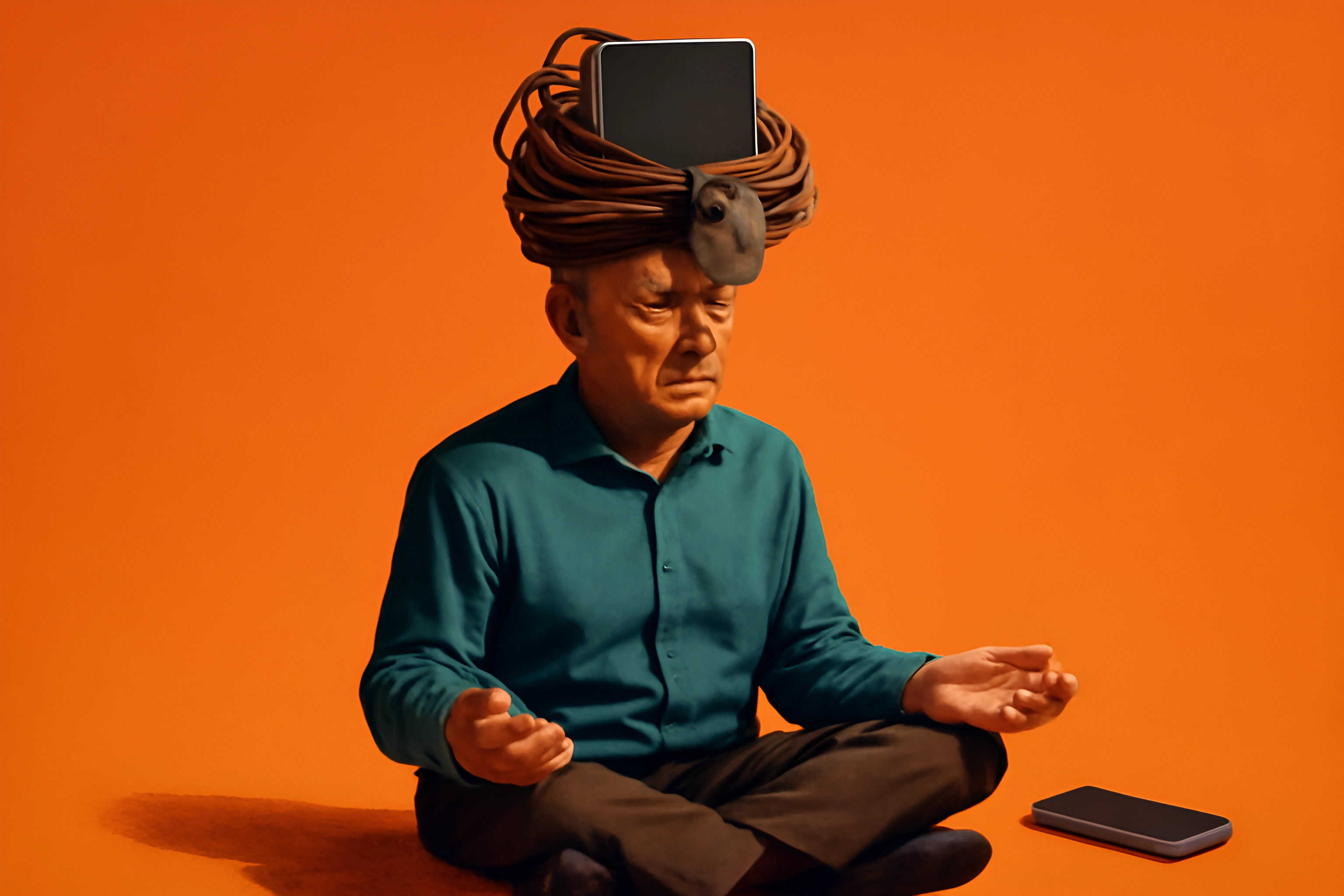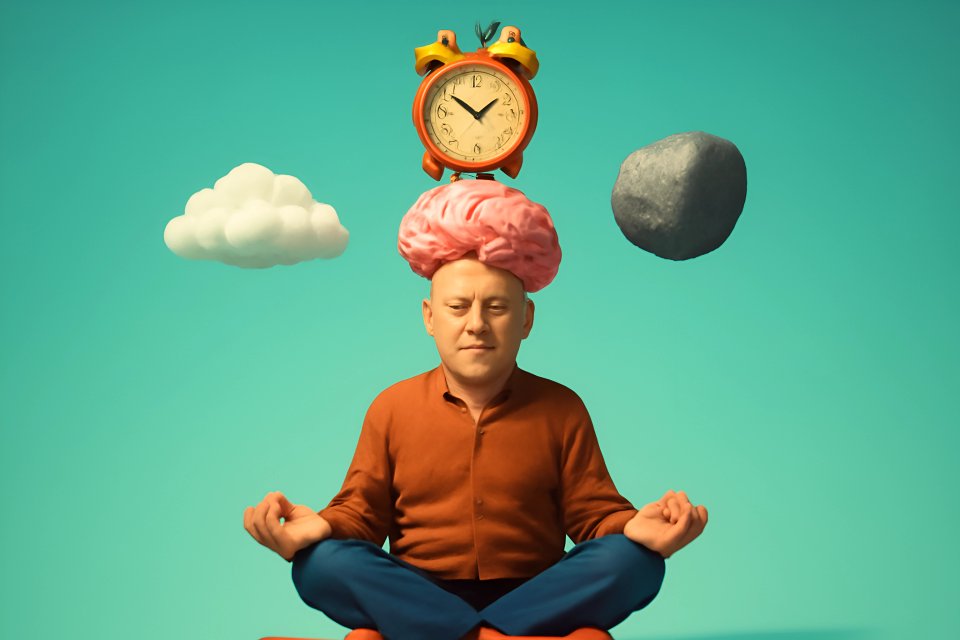
Does this sound familiar? You pick up your phone to check one quick thing, and suddenly an hour has vanished. You feel a little more scattered, a little more tired, and maybe even a bit anxious.
Let’s be clear: technology is a wonderful tool. It keeps us connected to our grandkids across the country, helps us manage our health, and allows us to explore hobbies we never had time for before. This isn't an attack on your smartphone; it's a guide to reclaiming your peace of mind in a world that never stops buzzing.
The truth is, this constant connectivity comes at a cost. This "digital overload" can quietly erode our mental peace, disrupt our precious sleep, and diminish our ability to be truly present in our own lives. But what if you could take back control? This is your invitation to a mindful digital detox—not about total disconnection, but about creating a healthier, more intentional relationship with your devices. By the end of this article, you will have a clear, gentle plan to create a balance that works for your lifestyle, boosting your well-being for years to come.
Why a Digital Reset Matters More Than Ever After 50
Reclaiming Your Focus and Mental Clarity
Remember a time when you could sit and read a book for an hour without a single interruption? In our modern world, every ping, buzz, and notification is designed to shatter that focus. This constant context-switching fragments our attention, leaving us feeling mentally cluttered and unable to concentrate on one thing at a time.
After 50, many of us crave a life of more presence and less noise. We want the mental space to think deeply, enjoy our hobbies, and engage in meaningful conversations. Reclaiming your focus isn't just about productivity; it's about restoring a sense of calm and control over your own mind.
This isn't just a feeling; it's backed by science. Studies show that taking intentional breaks from screens can have a profound impact on our cognitive health. Research from leading institutions has demonstrated that limiting screen time can enhance brain activity and neuroplasticity, which is absolutely vital for maintaining mental agility as we age.
The Crucial Link Between Blue Light and Quality Sleep
Are you struggling to get the deep, restorative sleep you need? Your devices might be the culprit. Screens on phones, tablets, and televisions emit a powerful blue light that sends a "wake up" signal to your brain, suppressing the production of melatonin, the hormone that governs your sleep-wake cycle.
For those of us over 50, quality sleep is non-negotiable. It is the foundation for our energy levels, cognitive function, immune health, and emotional resilience. When sleep suffers, everything else feels ten times harder.
Protecting your sleep is one of the most powerful acts of self-care you can perform. Authoritative health sources like the Mayo Clinic confirm that limiting screen time for at least an hour before bed is a critical step in improving sleep hygiene. By creating a screen-free wind-down period, you allow your brain to naturally prepare for the deep rest it needs to repair and recharge.
Escaping the Comparison Trap and Nurturing Your Emotional Health
Have you ever scrolled through social media and felt a pang of… something? Maybe it’s seeing someone’s picture-perfect retirement vacation or flawless family gathering. This curated reality can create a subtle but powerful pressure, leading to feelings of inadequacy, anxiety, or the sense that you aren't doing "enough."
This "comparison trap" is a silent drain on our emotional well-being. It pulls us out of gratitude for our own lives and into a cycle of wanting and worrying. A mindful digital detox allows you to step away from that endless feed and reconnect with your own reality and your own accomplishments.
The positive impact of this is significant. A comprehensive systematic review published in PubMed Central found that digital detox interventions significantly reduce depressive symptoms, especially for individuals who are already feeling the weight of low mood. Taking a deliberate step back is a proven strategy to nurture your emotional health.
Reducing "Information Fatigue" and Chronic Stress
The 24/7 news cycle and constant stream of information can feel like drinking from a firehose. This relentless exposure keeps our nervous systems in a low-grade state of alert, contributing to what is known as "information fatigue." This can manifest as anxiety, irritability, and a pervasive sense of being overwhelmed.
This isn't just in your head; it has a physiological impact. The constant state of alert can elevate cortisol, our primary stress hormone, which over time can affect everything from our sleep to our immune system. Stepping away from the screen is a direct way to lower the volume on this external chaos.
By consciously choosing when and how you consume information, you are taking a powerful step to protect your inner peace. As noted in the Anti-Aging Eastern Europe Journal, a digital detox is a holistic approach to reduce stress and enhance overall well-being, promoting a profound sense of calm.
Your Gentle Guide: A Mindful Digital Detox for Older Adults
Step 1: Start with Awareness, Not Judgment
The first step toward any meaningful change is simply to know where you stand. Before you can reduce your screen time, you need to know what it is. Most smartphones have a built-in tool to help you with this, often without needing to download a thing.
On an iPhone, you can find this information under Settings > Screen Time. For Android users, look for Settings > Digital Wellbeing & parental controls. Take a look at your daily average and which apps are consuming most of your time.
Remember, this is a judgment-free exercise. It might be surprising to learn that many seniors now spend more than four hours daily on devices, so whatever your number is, you are not alone. This is simply your baseline—the starting point from which you will empower yourself to make small, positive changes.
Step 2: Create "Screen-Free" Sanctuaries
Your home should be your sanctuary, a place of rest and rejuvenation. A powerful way to support this is by designating certain areas as completely screen-free zones. The most important of these is your bedroom.
Make it your number one rule: no phones, tablets, or laptops in the bedroom. This single change protects your sleep from the disruptive effects of blue light and the mental activation that comes from late-night scrolling. If you use your phone as an alarm, consider investing in a simple, traditional alarm clock to reclaim your bedside table.
The dinner table is another excellent candidate for a screen-free sanctuary. Whether you live with a partner, family, or by yourself, mealtimes are a perfect opportunity to disconnect from the digital world and reconnect with your food, your thoughts, and the people around you. This simple act can transform a routine meal into a mindful, restorative experience.
Step 3: Set Intentional Boundaries (Not Rigid Rules)
A successful digital detox is built on flexible, intentional boundaries, not on rigid, unforgiving rules. One of the most effective boundaries you can set is the "First and Last Hour" principle. Commit to not looking at your phone for the first hour after you wake up and the last hour before you go to sleep.
This allows you to start your day on your own terms—with meditation, stretching, or a quiet cup of coffee—instead of reacting to a flood of emails and news alerts. In the evening, it gives your brain the crucial time it needs to wind down for restful sleep. Another game-changing boundary is to curb your notifications; turn off all non-essential alerts so that your phone stops demanding your attention and instead waits for you to grant it.
Ultimately, this is about shifting the power dynamic. You are in control of your technology, not the other way around. These simple boundaries are a declaration that your time and your attention are your most valuable resources, and you are choosing how to spend them.
Step 4: Replace Scrolling with Soul-Fulfilling Activities
The secret to a sustainable digital detox is not just about removing a habit, but about replacing it with something more rewarding. When you create a void by putting down your phone, you must fill it with activities that genuinely nourish your soul. This is where the magic happens.
Think about what truly brings you joy, peace, or a sense of accomplishment. What hobbies have you let slide? What simple pleasures have been pushed aside by the convenience of the screen?
Here are a few ideas to get you started, tailored for the FitOverFifty lifestyle:
- Pick up a physical book or magazine.
- Listen to a podcast or an audiobook while taking a walk.
- Do a 10-minute stretching routine.
- Call a friend or family member for a real conversation.
- Spend time in the garden or on a patio, simply observing nature.
- Work on a puzzle or a hands-on hobby like knitting or woodworking.
Overcoming the Hurdles: "But What If...?"
"...I need my phone to stay connected with family?"
This is a valid and important concern. The goal is not to isolate yourself; it's to make your connections more meaningful. We need to reframe our usage from passive scrolling to active connecting.
Instead of just watching their lives unfold on a social media feed, be intentional. The fix is to shift your behavior from:
Passive Scrollingto:
Active ConnectingSchedule a weekly video call with your grandkids where they have your undivided attention. Send a thoughtful text message to a friend instead of just "liking" their post. Use your technology as a tool for deep, one-on-one connection, not as a substitute for it.
"...I'll feel bored or out of the loop?"
That feeling of boredom is something our constantly-stimulated brains have been trained to avoid at all costs. But what if boredom isn't the enemy? What if it's actually a gift?
Acknowledge that this feeling is normal at first, but then lean into it. Philosophers and artists have long known that boredom is the birthplace of creativity, reflection, and new ideas. It's in those quiet, "in-between" moments that we reconnect with ourselves and our own thoughts.
This is your opportunity to rediscover old hobbies or simply enjoy the profound peace of being present in your surroundings. You aren't "out of the loop"; you are deeply in the loop of your own life, and that is a far more rewarding place to be.
"...I use apps for health, fitness, or meditation?"
This is a perfect example of using technology for its intended, positive purpose. The key here is not to eliminate these helpful tools, but to use them with intention and focus. This is a core principle of a mindful, strategic reduction in device use.
The fix is simple: practice mindful app usage. When you want to meditate, open your meditation app, complete your session, and then close the app. When you want to log a workout, open your fitness tracker, enter the information, and put your phone away.
Avoid the temptation to get sidetracked by a notification that pops up or to "just quickly check" your email after you're done. Use the tool for its purpose, and then reclaim your time. This reinforces your role as the master of your device, using it deliberately to enhance your well-being.
Your New Chapter: More Presence, Less Pressure
Let's bring it all together. By being more mindful of your digital habits, you can unlock incredible benefits: deeper sleep, sharper focus, and a profound sense of inner peace. The strategy is simple and gentle: start with awareness, create screen-free sanctuaries, set intentional boundaries, and replace mindless scrolling with soul-fulfilling activities.
This isn't about ditching technology; it's about using it on your own terms. By being mindful of your digital habits, you are making a powerful investment in your mental health and reclaiming your most precious resource: your time. You are choosing a life of more presence and less pressure.
What is one small change you're inspired to make this week? Share your goal in the comments below—we’d love to cheer you on!
For more ideas on building healthy habits, explore our guide to Mindful Habits for Better Sleep: Evening Routines for 50+ Wellness.
















